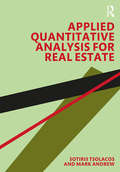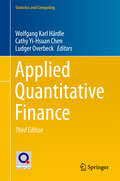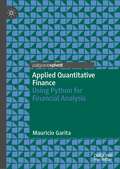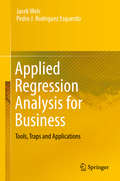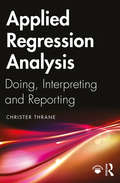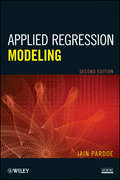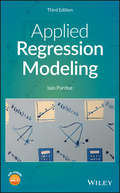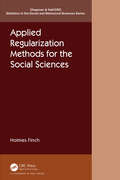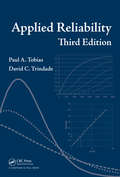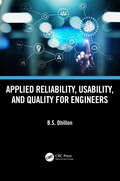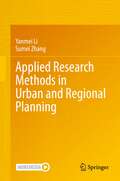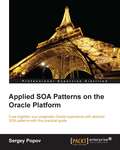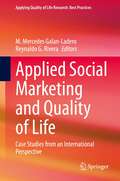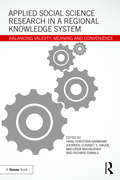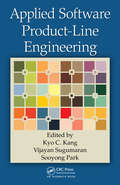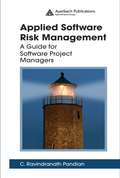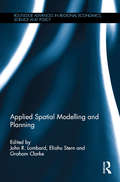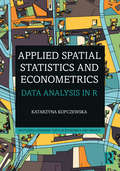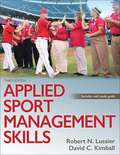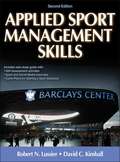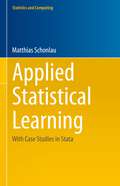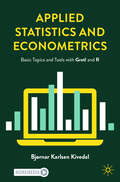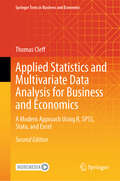- Table View
- List View
Applied Quantitative Analysis for Real Estate
by Sotiris Tsolacos Mark AndrewTo fully function in today’s global real estate industry, students and professionals increasingly need to understand how to implement essential and cutting-edge quantitative techniques. This book presents an easy-to-read guide to applying quantitative analysis in real estate aimed at non-cognate undergraduate and masters students, and meets the requirements of modern professional practice. Through case studies and examples illustrating applications using data sourced from dedicated real estate information providers and major firms in the industry, the book provides an introduction to the foundations underlying statistical data analysis, common data manipulations and understanding descriptive statistics, before gradually building up to more advanced quantitative analysis, modelling and forecasting of real estate markets. Our examples and case studies within the chapters have been specifically compiled for this book and explicitly designed to help the reader acquire a better understanding of the quantitative methods addressed in each chapter. Our objective is to equip readers with the skills needed to confidently carry out their own quantitative analysis and be able to interpret empirical results from academic work and practitioner studies in the field of real estate and in other asset classes. Both undergraduate and masters level students, as well as real estate analysts in the professions, will find this book to be essential reading.
Applied Quantitative Finance (Statistics and Computing)
by Wolfgang Karl Härdle Cathy Yi-Hsuan Chen Ludger OverbeckThis volume provides practical solutions and introduces recent theoretical developments in risk management, pricing of credit derivatives, quantification of volatility and copula modeling. This third edition is devoted to modern risk analysis based on quantitative methods and textual analytics to meet the current challenges in banking and finance. It includes 14 new contributions and presents a comprehensive, state-of-the-art treatment of cutting-edge methods and topics, such as collateralized debt obligations, the high-frequency analysis of market liquidity, and realized volatility. The book is divided into three parts: Part 1 revisits important market risk issues, while Part 2 introduces novel concepts in credit risk and its management along with updated quantitative methods. The third part discusses the dynamics of risk management and includes risk analysis of energy markets and for cryptocurrencies. Digital assets, such as blockchain-based currencies, have become popular but are theoretically challenging when based on conventional methods. Among others, it introduces a modern text-mining method called dynamic topic modeling in detail and applies it to the message board of Bitcoins. The unique synthesis of theory and practice supported by computational tools is reflected not only in the selection of topics, but also in the fine balance of scientific contributions on practical implementation and theoretical concepts. This link between theory and practice offers theoreticians insights into considerations of applicability and, vice versa, provides practitioners convenient access to new techniques in quantitative finance. Hence the book will appeal both to researchers, including master and PhD students, and practitioners, such as financial engineers. The results presented in the book are fully reproducible and all quantlets needed for calculations are provided on an accompanying website. The Quantlet platform quantlet. de, quantlet. com, quantlet. org is an integrated QuantNet environment consisting of different types of statistics-related documents and program codes. Its goal is to promote reproducibility and offer a platform for sharing validated knowledge native to the social web. QuantNet and the corresponding Data-Driven Documents-based visualization allows readers to reproduce the tables, pictures and calculations inside this Springer book.
Applied Quantitative Finance: Using Python for Financial Analysis
by Mauricio GaritaThis book provides both conceptual knowledge of quantitative finance and a hands-on approach to using Python. It begins with a description of concepts prior to the application of Python with the purpose of understanding how to compute and interpret results. This book offers practical applications in the field of finance concerning Python, a language that is more and more relevant in the financial arena due to big data. This will lead to a better understanding of finance as it gives a descriptive process for students, academics and practitioners.
Applied Regression Analysis for Business: Tools, Traps and Applications
by Jacek Welc Pedro J. Rodriguez EsquerdoThis book offers hands-on statistical tools for business professionals by focusing on the practical application of a single-equation regression. The authors discuss commonly applied econometric procedures, which are useful in building regression models for economic forecasting and supporting business decisions. A significant part of the book is devoted to traps and pitfalls in implementing regression analysis in real-world scenarios. The book consists of nine chapters, the final two of which are fully devoted to case studies. Today's business environment is characterised by a huge amount of economic data. Making successful business decisions under such data-abundant conditions requires objective analytical tools, which can help to identify and quantify multiple relationships between dozens of economic variables. Single-equation regression analysis, which is discussed in this book, is one such tool. The book offers a valuable guide and is relevant in various areas of economic and business analysis, including marketing, financial and operational management.
Applied Regression Analysis: Doing, Interpreting and Reporting
by Christer ThraneThis book is an introduction to regression analysis, focusing on the practicalities of doing regression analysis on real-life data. Contrary to other textbooks on regression, this book is based on the idea that you do not necessarily need to know much about statistics and mathematics to get a firm grip on regression and perform it to perfection. This non-technical point of departure is complemented by practical examples of real-life data analysis using statistics software such as Stata, R and SPSS. Parts 1 and 2 of the book cover the basics, such as simple linear regression, multiple linear regression, how to interpret the output from statistics programs, significance testing and the key regression assumptions. Part 3 deals with how to practically handle violations of the classical linear regression assumptions, regression modeling for categorical y-variables and instrumental variable (IV) regression. Part 4 puts the various purposes of, or motivations for, regression into the wider context of writing a scholarly report and points to some extensions to related statistical techniques. This book is written primarily for those who need to do regression analysis in practice, and not only to understand how this method works in theory. The book’s accessible approach is recommended for students from across the social sciences.
Applied Regression Modeling
by Iain PardoePraise for the First Edition"The attention to detail is impressive. The book is very well written and the author is extremely careful with his descriptions . . . the examples are wonderful." --The American StatisticianFully revised to reflect the latest methodologies and emerging applications, Applied Regression Modeling, Second Edition continues to highlight the benefits of statistical methods, specifically regression analysis and modeling, for understanding, analyzing, and interpreting multivariate data in business, science, and social science applications.The author utilizes a bounty of real-life examples, case studies, illustrations, and graphics to introduce readers to the world of regression analysis using various software packages, including R, SPSS, Minitab, SAS, JMP, and S-PLUS. In a clear and careful writing style, the book introduces modeling extensions that illustrate more advanced regression techniques, including logistic regression, Poisson regression, discrete choice models, multilevel models, and Bayesian modeling.In addition, the Second Edition features clarification and expansion of challenging topics, such as:Transformations, indicator variables, and interactionTesting model assumptionsNonconstant varianceAutocorrelationVariable selection methodsModel building and graphical interpretationThroughout the book, datasets and examples have been updated and additional problems are included at the end of each chapter, allowing readers to test their comprehension of the presented material. In addition, a related website features the book's datasets, presentation slides, detailed statistical software instructions, and learning resources including additional problems and instructional videos.With an intuitive approach that is not heavy on mathematical detail, Applied Regression Modeling, Second Edition is an excellent book for courses on statistical regression analysis at the upper-undergraduate and graduate level. The book also serves as a valuable resource for professionals and researchers who utilize statistical methods for decision-making in their everyday work.
Applied Regression Modeling: A Business Approach
by Iain PardoeMaster the fundamentals of regression without learning calculus with this one-stop resource The newly and thoroughly revised 3rd Edition of Applied Regression Modeling delivers a concise but comprehensive treatment of the application of statistical regression analysis for those with little or no background in calculus. Accomplished instructor and author Dr. Iain Pardoe has reworked many of the more challenging topics, included learning outcomes and additional end-of-chapter exercises, and added coverage of several brand-new topics including multiple linear regression using matrices. The methods described in the text are clearly illustrated with multi-format datasets available on the book's supplementary website. In addition to a fulsome explanation of foundational regression techniques, the book introduces modeling extensions that illustrate advanced regression strategies, including model building, logistic regression, Poisson regression, discrete choice models, multilevel models, Bayesian modeling, and time series forecasting. Illustrations, graphs, and computer software output appear throughout the book to assist readers in understanding and retaining the more complex content. Applied Regression Modeling covers a wide variety of topics, like: Simple linear regression models, including the least squares criterion, how to evaluate model fit, and estimation/prediction Multiple linear regression, including testing regression parameters, checking model assumptions graphically, and testing model assumptions numerically Regression model building, including predictor and response variable transformations, qualitative predictors, and regression pitfalls Three fully described case studies, including one each on home prices, vehicle fuel efficiency, and pharmaceutical patches Perfect for students of any undergraduate statistics course in which regression analysis is a main focus, Applied Regression Modeling also belongs on the bookshelves of non-statistics graduate students, including MBAs, and for students of vocational, professional, and applied courses like data science and machine learning.
Applied Regularization Methods for the Social Sciences (Chapman & Hall/CRC Statistics in the Social and Behavioral Sciences)
by Holmes FinchResearchers in the social sciences are faced with complex data sets in which they have relatively small samples and many variables (high dimensional data). Unlike the various technical guides currently on the market, Applied Regularization Methods for the Social Sciences provides and overview of a variety of models alongside clear examples of hands-on application. Each chapter in this book covers a specific application of regularization techniques with a user-friendly technical description, followed by examples that provide a thorough demonstration of the methods in action. Key Features: Description of regularization methods in a user friendly and easy to read manner Inclusion of regularization-based approaches for a variety of statistical analyses commonly used in the social sciences, including both univariate and multivariate models Fully developed extended examples using multiple software packages, including R, SAS, and SPSS Website containing all datasets and software scripts used in the examples Inclusion of both frequentist and Bayesian regularization approaches Application exercises for each chapter that instructors could use in class, and independent researchers could use to practice what they have learned from the book
Applied Reliability
by Paul A. Tobias David TrindadeSince the publication of the second edition of Applied Reliability in 1995, the ready availability of inexpensive, powerful statistical software has changed the way statisticians and engineers look at and analyze all kinds of data. Problems in reliability that were once difficult and time consuming even for experts can now be solved with a few well
Applied Reliability, Usability, and Quality for Engineers
by B.S. DhillonGlobal competition is forcing reliability and other professionals to work closely during the product design and manufacturing phase. Because of this collaboration, reliability, usability, and quality principles are being applied across many diverse sectors of the economy. This book offers the principles, methods, and procedures for these areas in one resource. This book brings together the areas of reliability, usability, and quality for those working in diverse areas to allow them to be exposed to activities that can help them perform their tasks more effectively. This is the only book that covers these areas together in this manner and written in such a way that no previous knowledge is required to understand it. The sources of the material presented are included in the reference section at the end of each chapter along with examples and solutions to test reader comprehension. Applied Reliability, Usability, and Quality for Engineers is useful to design, manufacturing, and systems engineers, as well as manufacturing managers, reliability, usability and, quality specialists. It can also be helpful to graduate, senior undergraduate students, and instructors.
Applied Research Methods in Urban and Regional Planning
by Yanmei Li Sumei ZhangThis book introduces the fundamentals of research methods and how they apply to the discipline of urban and regional planning. Written at a level appropriate for upper-level undergraduate and beginning master’s level students, the text fills a gap in the literature for textbooks on urban planning. Additionally, the book can be used as a reference for planning practitioners and researchers when analyzing quantitative and qualitative data in urban and regional planning and related fields.The volume does not assume advanced knowledge of mathematical formulas. Rather, it begins with the essentials of research methods, such as the identification of the research problems in planning, the literature review, data collection and presentation, descriptive data analysis, and report of findings. Its discipline-specific topics include field research methods, qualitative data analysis, economic and demographic analysis, evaluation research, and methods in sub-disciplines such as land use planning, transportation planning, environmental planning, and housing analysis. Designed with instruction in mind, this book features downloadable materials, including learning outcomes, chapter highlights, chapter review questions, datasets, and certain Excel models. Students will be able to download review questions to enhance the learning process and datasets to practice methods.
Applied Research Technologies, Inc.: Global Innovation's Challenges
by Christopher A. Bartlett Heather BeckhamApplied Research Technologies, Inc. (ART) is a diversified technology company which has used its entrepreneurial culture and encouragement of innovation as an ongoing competitive advantage. The case concentrates on the challenges faced by Peter Vyas, the Filtration Unit manager, who must decide whether to request $2 million in project funding from the divisional vice president, Cynthia Jackson. Similar Filtration projects have failed twice before, damaging the credibility of the Filtration Unit and Vyas personally. Jackson has recently been challenged to turn around or shut down the unit. Students must determine a strategy from the perspectives of both a unit manager and a division VP. This two-tier focus provides the opportunity to analyze the management decision process at different levels of the organization. Topics include empowerment, project management, and managing innovation.
Applied Research Technologies, Inc.: Global Innovation's Challenges
by Christopher A. Bartlett Heather BeckhamApplied Research Technologies, Inc. (ART) is a diversified technology company which has used its entrepreneurial culture and encouragement of innovation as an ongoing competitive advantage. The case concentrates on the challenges faced by Peter Vyas, the Filtration Unit manager, who must decide whether to request $2 million in project funding from the divisional vice president, Cynthia Jackson. Similar Filtration projects have failed twice before, damaging the credibility of the Filtration Unit and Vyas personally. Jackson has recently been challenged to turn around or shut down the unit. Students must determine a strategy from the perspectives of both a unit manager and a division VP. This two-tier focus provides the opportunity to analyze the management decision process at different levels of the organization. Topics include empowerment, project management, and managing innovation.
Applied SOA Patterns on the Oracle Platform
by Sergey PopovApplied SOA Patterns on the Oracle Platform is aimed at architects practicing SOA or traditional integration, and also at technical team leaders implementing Oracle Fusion under SCRUM or WF methodology.
Applied Social Marketing and Quality of Life: Case Studies from an International Perspective (Applying Quality of Life Research)
by M. Mercedes Galan-Ladero Reynaldo G. RiveraThis book discusses how various social marketing campaigns have taken up and had an impact on important aspects of quality of life across the world. The chapters bring up case studies from different regions, showing how successful social marketing campaigns have been instrumental in addressing public health challenges, discrimination and exclusion, violence, and inequity; and in changing public perceptions in different countries and through public and nonprofit organizations, but also through businesses. Thus, this book approaches social marketing from a quality-of-life (QOL) marketing philosophy, taking an international perspective. It includes 26 case studies discussing how social marketing campaigns were developed and implemented in specific cases related to disease prevention and risk behavior, safe and healthy lifestyles, and inclusion and interpersonal relationships. It also covers social marketing campaigns related to COVID-19 in various countries. The book is both comprehensive and provides in-depth understanding of every case, and is useful for research, policy making, development communication and social marketing. Graduate students, researchers, practitioners, and social marketers alike will find this book interesting.
Applied Social Science Research in a Regional Knowledge System: Balancing validity, meaning and convenience
by Richard Ennals Hans Christian Garmann Johnsen Elisabet S. Hauge May-Linda MagnussenThis book illustrates how applied social scientists and their research are integrated with stakeholders and practitioners in a local/regional setting, and how knowledge development is a mutual concern, made in, and dependent on, ongoing dialogue. Focusing on the Agder region, the southernmost region in Norway, researchers and contributors question what impact the changing economic environment will have on applied researchers around the world. Applied research is seen as a vital part of the infrastructure for economic and social development, in the Agder region and beyond. The chapters are divided into four parts: the spatial dimension of knowledge development; understanding regional practice; explaining regional practice; influencing regional social practice. A useful resource for both policy makers and researchers, the book helps readers reflect on the type of mutual competence building that applied social science research implies, and depends on, in a regional knowledge development process. It represents a voice on how to understand the development of the knowledge society at regional and global levels.
Applied Software Product Line Engineering
by Kang Vijayan Sugumaran Sooyong ParkOver the last decade, software product line engineering (SPLE) has emerged as one of the most promising software development paradigms for increasing productivity in IT-related industries. Detailing the various aspects of SPLE implementation in different domains, Applied Software Product Line Engineering documents best practices with regard to syst
Applied Software Risk Management: A Guide for Software Project Managers
by C. Ravindranath PandianFew software projects are completed on time, on budget, and to their original specifications. Focusing on what practitioners need to know about risk in the pursuit of delivering software projects, Applied Software Risk Management: A Guide for Software Project Managers covers key components of the risk management process and the software development
Applied Spatial Modelling and Planning (Routledge Advances in Regional Economics, Science and Policy)
by John R. Lombard, Eliahu Stern and Graham ClarkeThis book highlights the extraordinary range of areas to which geographical analysis and spatial modelling can bring lessons and insights. It shows how these techniques have been used to address ‘real world’ issues that are of concern to international organisations, public agencies and businesses, as illustrated by actual funded projects that geographers have developed collaboratively with end-users. Applied Spatial Modelling and Planning shows how much geographical research is policy relevant to a wide variety of agencies through the use of GIS and spatial modelling in applied geography. The book’s chapters contain a cross-section of innovative applications and approaches to problem solving within five major domains of the dynamics of economic space, housing and settlements, population movements and population ageing, health care, and the environment. Using a number of case studies on the use of GIS and spatial modelling, this book demonstrates the fact that much of what is done by quantitative geographers is not only relevant within academia, but also has use in policy work. This book will appeal to an international audience interested in cutting-edge spatial modelling to better understand the processes involved in solving real problems.
Applied Spatial Statistics and Econometrics: Data Analysis in R (Routledge Advanced Texts in Economics and Finance)
by Katarzyna KopczewskaThis textbook is a comprehensive introduction to applied spatial data analysis using R. Each chapter walks the reader through a different method, explaining how to interpret the results and what conclusions can be drawn. The author team showcases key topics, including unsupervised learning, causal inference, spatial weight matrices, spatial econometrics, heterogeneity and bootstrapping. It is accompanied by a suite of data and R code on Github to help readers practise techniques via replication and exercises. This text will be a valuable resource for advanced students of econometrics, spatial planning and regional science. It will also be suitable for researchers and data scientists working with spatial data.
Applied Sport Management Skills
by David Kimball Robert Lussier<p>Applied Sport Management Skills, Third Edition With Web Study Guide, takes a unique and effective approach to teaching students how to become strong leaders and managers in the world of sport. Organized around the central management functions—planning, organizing, leading, and controlling—this third edition addresses the Common Professional Component topics outlined by the Commission on Sport Management Accreditation (COSMA). <p>The text explains important concepts but then takes the student beyond theories, to applying those management principles and developing management skills. This practical how-to approach, accompanied by unmatched learning tools, helps students put concepts into action as sport managers—developing the skills of creative problem solving and strategic planning, and developing the ability to lead, organize, and delegate.</p>
Applied Sport Management Skills 2nd Edition
by David C. Kimball Robert N. LussierApplied Sport Management Skills, Second Edition uses the four management functions of planning, organizing, leading, and controlling to teach students how to become strong leaders and managers in the world of sport. This comprehensive and fully updated text provides an overview of management topics with a unique focus on developing the skills necessary for managing sport organizations.
Applied Statistical Learning: With Case Studies in Stata (Statistics and Computing)
by Matthias SchonlauThis textbook provides an accessible overview of statistical learning methods and techniques, and includes case studies using the statistical software Stata. After introductory material on statistical learning concepts and practical aspects, each further chapter is devoted to a statistical learning algorithm or a group of related techniques. In particular, the book presents logistic regression, regularized linear models such as the Lasso, nearest neighbors, the Naive Bayes classifier, classification trees, random forests, boosting, support vector machines, feature engineering, neural networks, and stacking. It also explains how to construct n-gram variables from text data. Examples, conceptual exercises and exercises using software are featured throughout, together with case studies in Stata, mostly from the social sciences; true to the book’s goal to facilitate the use of modern methods of data science in the field. Although mainly intended for upper undergraduate and graduate students in the social sciences, given its applied nature, the book will equally appeal to readers from other disciplines, including the health sciences, statistics, engineering and computer science.
Applied Statistics and Econometrics: Basic Topics and Tools with Gretl and R
by Bjørnar Karlsen KivedalThis accessible textbook introduces the foundations of applied econometrics and statistics for undergraduate students. It covers key topics in econometrics by using step-by-step examples in Gretl and R, providing a guide to using statistical software and the tools for econometric analysis in one self-contained resource. Taking a concise, non-technical approach, the book covers topics including simple regression and hypothesis testing, multiple regression with control variables and isolating effects, instrumental variables, dummy variables, non-linear effects, probability models, heteroskedasticity, time series analysis, and other applied statistical tools such as t-tests and chi squared tests. The book uses small data sets to easily facilitate students’ transition from manual statistical calculations to using and understanding statistical software, including step-by-step examples of regression analysis, as well as additional chapters to aid with econometric notation and mathematical prerequisites, and accompanying online exercises and data sets. This book will be a valuable resource for upper undergraduate students taking courses in introductory econometrics and statistics, as well as students in business administration and other fields of study in social sciences utilising quantitative methods. Graduate students may also benefit from the book.
Applied Statistics and Multivariate Data Analysis for Business and Economics: A Modern Approach Using R, SPSS, Stata, and Excel (Springer Texts in Business and Economics)
by Thomas CleffThis comprehensive textbook equips students of economics and business, as well as industry professionals, with essential principles, techniques, and applications of applied statistics, statistical testing, and multivariate data analysis. Through real-world business examples, it illustrates the practical use of univariate, bivariate, and multivariate statistical methods. The content spans a broad range of topics, from data collection and scaling to the presentation and fundamental univariate analysis of quantitative data, while also demonstrating advanced analytical techniques for exploring multivariate relationships. The book systematically covers all topics typically included in university-level courses on statistics and advanced applied data analysis. Beyond theoretical discussion, it offers hands-on guidance for using statistical software tools such as Excel, SPSS, Stata, and R. In this completely revised and updated second edition, new sections on logistic regression are included, along with enhanced examples and solutions using R for all covered statistical methods. This edition provides a robust resource for mastering applied statistics in both academic and professional settings.
